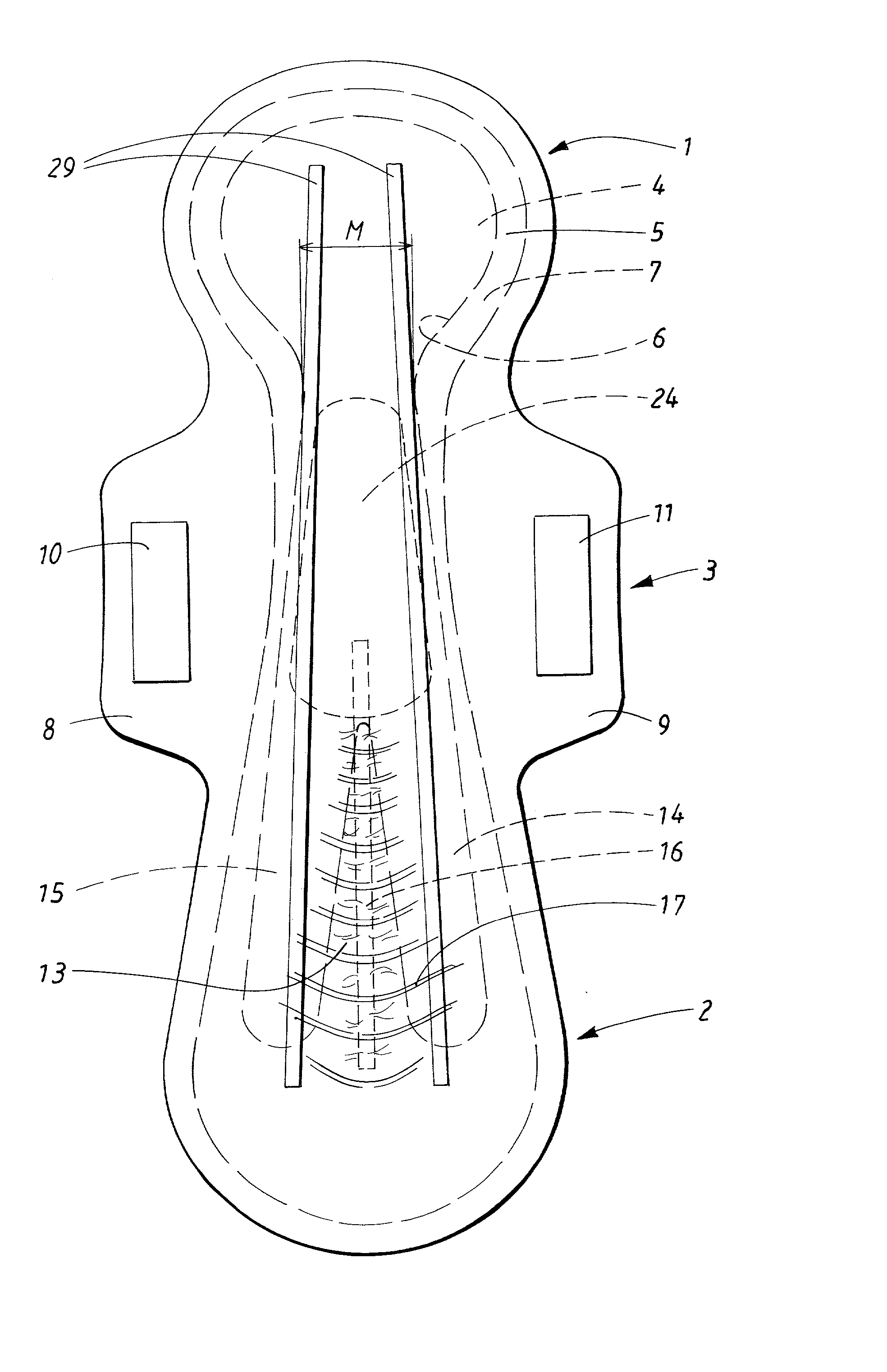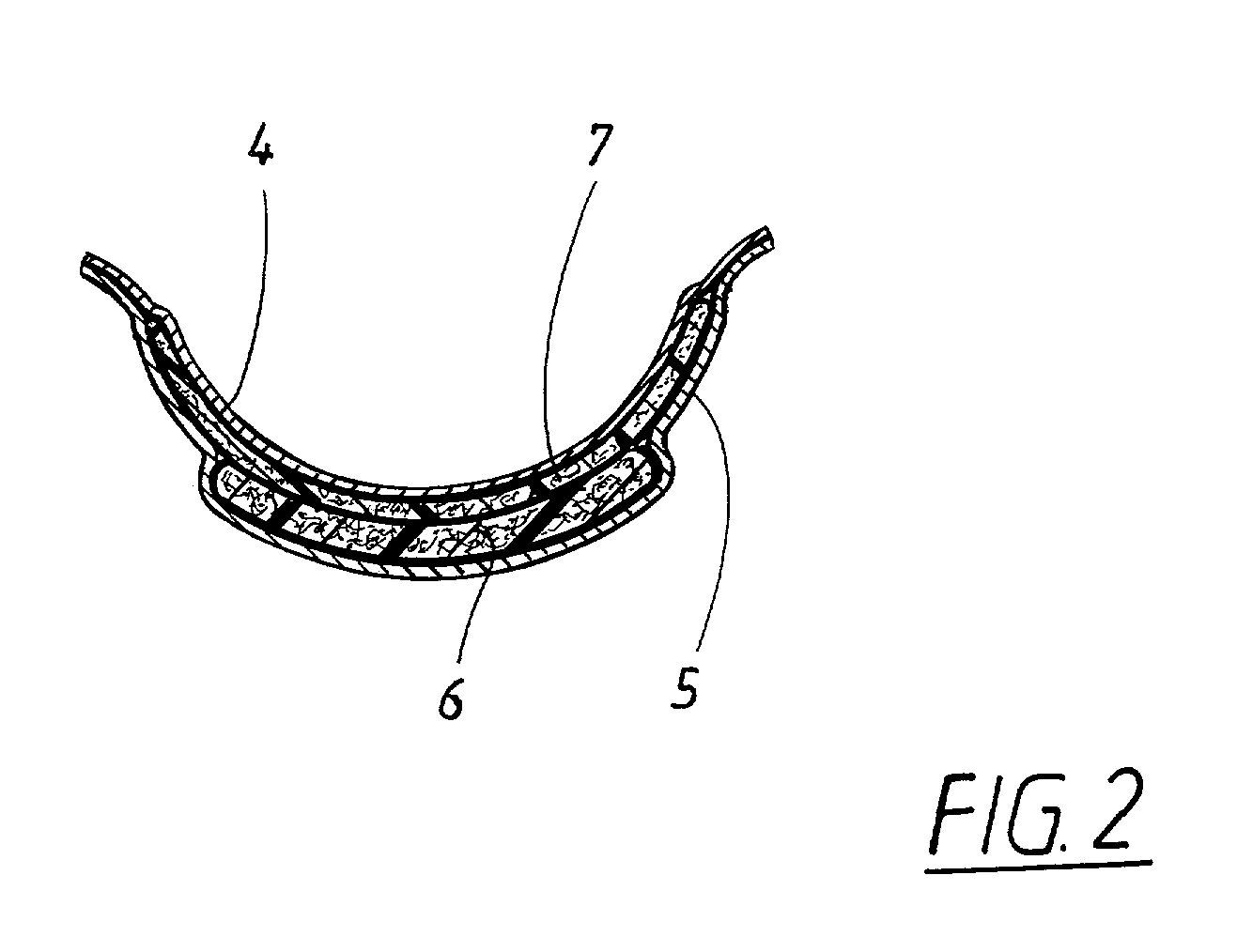A great many requirements are made of absorbent products, such as a sanitary towel, an incontinence pad, a nappy or the like, which are not easy to satisfy simultaneously.
Thick and relatively wide sanitary towels of this type theoretically have great
absorption capacity but in practice, when the sanitary towel is subjected to compression forces when squeezed together between the thighs of the wearer, much of the take-up capacity and
absorption capacity is lost.
The sanitary towel is squeezed together into an arbitrary
rope-like shape which frequently does not offer a sufficiently large receiving surface for the
menstrual fluid discharged, and leakage occurs in the case of heavy flows of
menstrual fluid.
There is therefore a risk of the sanitary towel being, by mistake, positioned too far forward or too far back or displaced slightly in the lateral direction and therefore of the
absorption capacity and receiving surface of the whole sanitary towel not being optimally utilized.
When fitting the product inside the briefs, however, it is difficult to achieve a positioning which is optimum in relation to the body of the wearer.
As sanitary towels are manufactured in a great many sizes and models, the position and design of the crotch portion provide a particularly unreliable indication of where in the briefs a sanitary towel is to be positioned, and the functioning of the sanitary towel during use is consequently not always as desired.
Another cause of leakage occurring past sanitary towels attached inside the briefs of the wearer is that the sanitary towel moves together with the briefs instead of following the body movements of the wearer.
However, a considerable
disadvantage of providing absorbent products with such attachment flaps is that many wearers find it embarrassing that the attachment flaps are visible on the outside of the briefs.
This also means that absorbent products with such attachment flaps cannot be used when, for example, the wearer is wearing a swimsuit.
Another
disadvantage of the attachment flaps is that they are relatively difficult to
handle and require many manual operations in order to be fitted correctly around the leg edges of the briefs.
Furthermore, especially in the case of attachment flaps which extend quite a long way along the side edges of a sanitary towel, it can be virtually impossible to fold the attachment flaps around the curved leg edges of the briefs without chafing and unattractive creases in the attachment flaps occurring.
A further problem of sanitary towels with attachment flaps is that the functioning of the attachment flaps or wings depends on the design of the briefs.
Attachment flaps or wings on sanitary towels protect the leg edges of the briefs from soiling but, as emerged above, are far from being an entirely satisfactory solution.
The mobility between the parts is, however, very limited, and the known sanitary towel is still dependent on the movements of the briefs.
Furthermore, there is no guarantee that the upper part will be held in contact with the body of the wearer during use.
This known product also has
limited mobility between the parts and is to a certain extent dependent on the movements of the briefs.
As the absorption material used is in most cases what is known as
cellulose fluff pulp, however, such a raised portion collapses and loses its shape when it is wetted.
In order to produce a raised portion which is sufficiently large in the wet state as well, a raised portion consisting of
cellulose fluff pulp must comprise so much absorption material that it is altogether too high, hard and uncomfortable to wear in the dry state.
The
disadvantage is that this interferes with the liquid transport down to the absorbent, liquid-retaining absorption core and that leakage can occur because the shaping element does not have sufficient admission capacity or temporary
retention capacity.
However, it has proved difficult to produce a foamed structure with sufficiently open pores for good liquid admission into the latter at the same time as the material is to have such great
retention capacity that liquid is not pressed out in the event of loading originating from the wearer, for example when the latter sits down.
Although such a raised portion functions well for its purpose, it has been found that when the raised portion is exposed to large quantities of bodily fluid over a relatively short period of time, there is a risk that some of the liquid will run on the outside of the raised portion and flow out past the side edges of the absorbent product.
Such leakage can occur, for example, when the wearer of a sanitary towel has been sitting or
lying down for a relatively long period of time and then suddenly rises.
A narrow raised portion of the type described in SE 507 798 does not then have a sufficiently large surface to be capable of receiving and absorbing the entire quantity of liquid in one go, for which reason such sudden liquid flows often result in leakage.
It is impossible, however, to control or predict entirely the shape the product will adopt for each individual wearer.
Moreover, it is not possible to ensure contact between the body of the wearer and the surface of the product, because the degree of bulging is determined entirely by how much the product is compressed in the transverse direction.
A considerable disadvantage of permanent three-dimensional products is that it is difficult to pack a stiff three-dimensional product.
Such products require a great deal of space for transport and sale, and it can be embarrassing for a wearer to carry around a sanitary towel or an incontinence pad which it is impossible to fold and therefore cannot be concealed in the hand or in the worst case will not even fit in a handbag.
The use of elastic complicates manufacture, and there is a risk of the intended elastic effect being lost in connection with packing of the product or when the latter is stored in a folded packing state.
A disadvantage of this bowl-like construction is that the borders hold the central portion of the sanitary towel at a distance from the genitals of the wearer, and liquid discharged from the wearer does not flow directly into the absorbent product but can run on the surface, the risk then being obvious that liquid may find an undesirable transport path in the form of a small crease or the like and run straight out of the product in the lateral or longitudinal direction.
Stamped channels in an absorption body also have the disadvantage that the liquid spread in the
absorption layer is disrupted and that absorption material outside the channels is not utilized, which increases the risk of local oversaturation and attendant leakage from those parts of the
absorption layer which are used.
 Login to View More
Login to View More  Login to View More
Login to View More 


